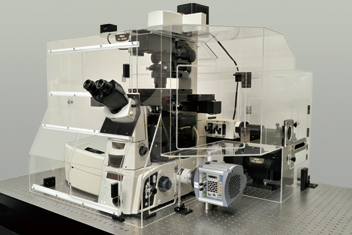
Confocal microscope A1+ configured with Ti-E
Nikon confocal microscope system A1+ provides high-resolution imaging of up to 4096 x 4096 pixels with a galvano (non-resonant) scanner. With diverse innovative optical and electronic technologies, such as the VAAS pinhole unit, superior image quality has been achieved.
High-resolution imaging with a galvano scanner
The A1+'s galvano scanner enables high-resolution imaging of up to 4096 x 4096 pixels. In addition, with the newly developed scanner driving and sampling systems, plus image correction technology, high-speed acquisition of 10 fps (512 x 512 pixels) is also possible.


Image of a zebrafish labeled with four probes (captured with galvano scanner)
Nucleus (blue): Hoechst33342, Pupil (green): GFP, Nerve (yellow): Alexa555, Muscle (red): Alexa647
Photographed with the cooperation of: Dr. Kazuki Horikawa and Prof. Takeharu Nagai, Research Institute for Electronic Science, Hokkaido University
Increased light detection efficiency realizes high image quality
The low-angle incidence method utilized on the dichroic mirrors increases fluorescence efficiency by 30%.

By employing the hexagonal pinhole, higher brightness equivalent to that of a circular pinhole is achieved.

Nikon's original dual integration signal processing technology (DISP) has been implemented in the image processing circuitry to improve electrical efficiency, resulting in an extremely high S/N ratio.
VAAS pinhole unit for bright, clear images
Nikon has developed an original confocal microscopy VAAS (Virtual Adaptable Aperture System, option) that can eliminate flare while retaining image brightness. Because of the deconvolution of the light that passes through the pinhole and the light that does not pass through the pinhole, acquisition of brighter images with less flare is possible. Different sectionings (slice thicknesses) can also be simulated after image acquisition.

Photographed with the cooperation of: Dr. Yasushi Okada, Laboratory for Cell Polarity Regulation, Quantitative Biology Center, RIKEN
Enhanced spectral imaging
High-speed spectral imaging
Acquisition of a 32-channel spectral image (512 x 512 pixels) with a single scan in 0.6 second is possible. Moreover, 512 x 32-pixel images can be captured at 24 fps.
Accurate, high-speed unmixing

Accurate spectral unmixing provides maximum performance in the separation of closely overlapping fluorescence spectra and the elimination of autofluorescence. Superior algorithms and high-speed data processing enable real time unmixing during image acquisition.

Actin of HeLa cell expressing H2B-YFP was stained with Phalloidin-Alexa488.
Spectral image in the 500-692 nm range captured with 488 nm laser excitation
Left: Spectral image, Right: Unmixed image (green: Alexa488, red: YFP)
Specimen courtesy of: Dr. Yoshihiro Yoneda and Dr. Takuya Saiwaki, Faculty of Medicine, Osaka University
Simultaneous excitation of four lasers
Three user-defined laser shields allow simultaneous use of four lasers selected from a maximum of nine colors, enabling broader band spectral imaging.
V-filtering function
Filter-less intensity adjustment is possible by selecting desired spectral ranges from 32 channels that match the spectrum of the fluorescence probe in use and combining them to perform the filtering function.

Simple operation of complex applications
NIS—Elements C control software enables integrated control of the confocal imaging system, microscope and peripheral devices with a simple and intuitive interface. Diverse reliable analysis functions are also available.

Basic operation

Optical setting

Configuration of A1+ with N-SIM
System integration of Ti-E inverted microscope for multi-mode imaging is possible by equipping the confocal microscope system with N-SIM/N-STORM super resolution microscope system, TIRF system, spectral detector and Perfect Focus System. All systems can be controlled by a single NIS-Elements platform.

